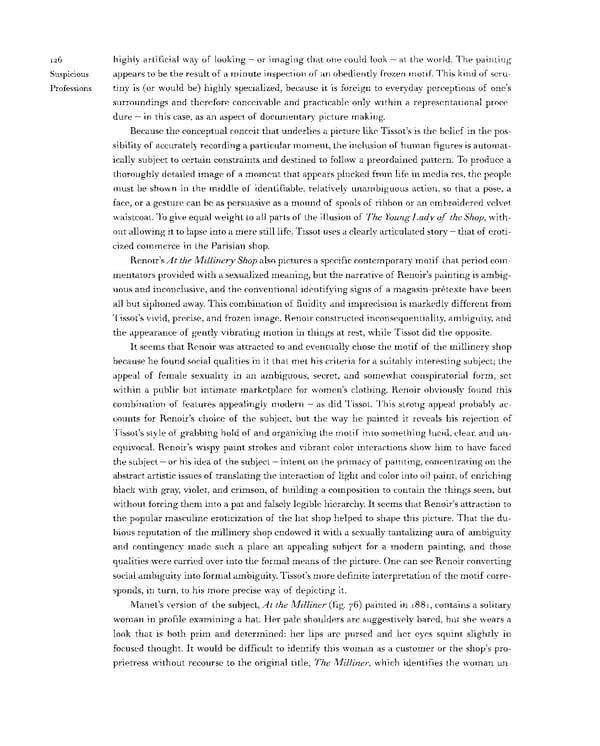126 highly artificial way of looking — or imaging that one could look — at the world. The painting Suspicious appears to be the result of a minute inspection of an obediently frozen motif. This kind of scru- Professions tiny is (or would be) highly specialized, because it is foreign to everyday perceptions of one's surroundings and therefore conceivable and practicable only within a representational proce- dure — in this case, as an aspect of documentary picture making. Because the conceptual conceit that underlies a picture like Tissot's is the belief in the pos- sibility of accurately recording a particular moment, the inclusion of human figures is automat- ically subject to certain constraints and destined to follow a preordained pattern. To produce a thoroughly detailed image of a moment that appears plucked from life in media res, the people must be shown in the middle of identifiable, relatively unambiguous action, so that a pose, a face, or a gesture can be as persuasive as a mound of spools of ribbon or an embroidered velvet waistcoat. To give equal weight to all parts of the illusion of The Young Lady of the Shop, with- out allowing it to lapse into a mere still life, Tissot uses a clearly articulated story — that of eroti- cized commerce in the Parisian shop. Renoir's At the Millinery Shop also pictures a specific contemporary motif that period com- mentators provided with a sexualized meaning, but the narrative of Renoir's painting is ambig- uous and inconclusive, and the conventional identifying signs of a magasin-pretexte have been all but siphoned away. This combination of fluidity and imprecision is markedly different from Tissot's vivid, precise, and frozen image. Renoir constructed inconsequentiality ambiguity, and the appearance of gently vibrating motion in things at rest, while Tissot did the opposite. It seems that Renoir was attracted to and eventually chose the motif of the millinery shop because he found social qualities in it that met his criteria for a suitably interesting subject; the appeal of female sexuality in an ambiguous, secret, and somewhat conspiratorial form, set within a public but intimate marketplace for women's clothing. Renoir obviously found this combination of features appealingly modern — as did Tissot. This strong appeal probably ac- counts for Renoir's choice of the subject, but the way he painted it reveals his rejection of Tissot's style of grabbing hold of and organizing the motif into something lucid, clear, and un- equivocal. Renoir's wispy paint strokes and vibrant color interactions show him to have faced the subject — or his idea of the subject — intent on the primacy of painting, concentrating on the abstract artistic issues of translating the interaction of light and color into oil paint, of enriching black with gray, violet, and crimson, of building a composition to contain the things seen, but without forcing them into a pat and falsely legible hierarchy. It seems that Renoir's attraction to the popular masculine eroticization of the hat shop helped to shape this picture. That the du- bious reputation of the millinery shop endowed it with a sexually tantalizing aura of ambiguity and contingency made such a place an appealing subject for a modern painting, and those qualities were carried over into the formal means of the picture. One can see Renoir converting social ambiguity into formal ambiguity. Tissot's more definite interpretation of the motif corre- sponds, in turn, to his more precise way of depicting it. Manet's version of the subject, At the Milliner (fig. 76) painted in 1881, contains a solitary woman in profile examining a hat. Her pale shoulders are suggestively bared, but she wears a look that is both prim and determined: her lips are pursed and her eyes squint slightly in focused thought. It would be difficult to identify this woman as a customer or the shop's pro- prietress without recourse to the original title, The Milliner, which identifies the woman un-
 Prostitution & Impressionists Page 146 Page 148
Prostitution & Impressionists Page 146 Page 148